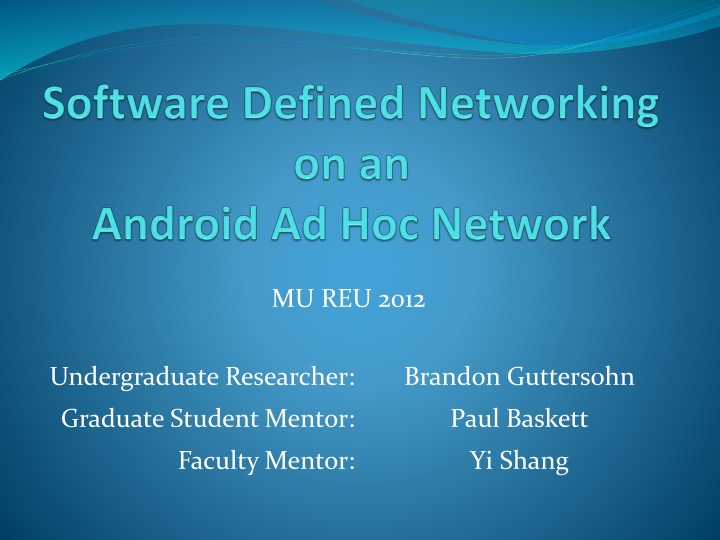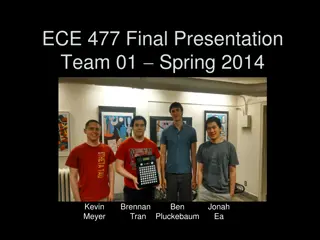
Enhancing Networking with Software Defined Solutions
Dive into the world of Software Defined Networking (SDN) and Mobile Ad Hoc Networks (MANETs) to understand their benefits, solutions they offer, and how they revolutionize traditional networking structures. Explore the challenges faced by current networks, the innovative approach of SDN, and the agility of MANETs in facilitating direct device-to-device communication. Discover the potential of centralized control, network abstraction, and advanced settings management through software-defined solutions.
Download Presentation

Please find below an Image/Link to download the presentation.
The content on the website is provided AS IS for your information and personal use only. It may not be sold, licensed, or shared on other websites without obtaining consent from the author. If you encounter any issues during the download, it is possible that the publisher has removed the file from their server.
You are allowed to download the files provided on this website for personal or commercial use, subject to the condition that they are used lawfully. All files are the property of their respective owners.
The content on the website is provided AS IS for your information and personal use only. It may not be sold, licensed, or shared on other websites without obtaining consent from the author.
E N D
Presentation Transcript
MU REU 2012 Undergraduate Researcher: Brandon Guttersohn Graduate Student Mentor: Paul Baskett Faculty Mentor: Yi Shang
Project Goal Implement a software structure which: Initializes an ad hoc network between Android devices Allows software manipulation of the network Provides an interface to 3rd party applications Primary Concepts: Software Defined Networking Mobile Ad Hoc Networks
Software Defined Networking What is wrong with current networks? Lack of transparency Almost entirely controlled by firmware No software abstraction for programming Distributed decision making Forwarding decisions made with only partial network view What problems does this produce? Stifles research and growth of the networking field Tedious network setups and modifications No central network controls
Software Defined Networking How does SDN solve this issue? Built around distributed software on network nodes Enables network abstraction Enables central network control Routing decisions made with whole network view What benefits can SDN bring? Advanced control of network settings via software Treating the network as a whole, rather than as individual network nodes.
Software Defined Networking Traditional Software Defined Network Switches Interface with OpenFlow Network Switches running Network Operating System instances Server running Network Control Software End-User Devices
Mobile Ad Hoc Networks Direct device-to-device data transmission Each device serves two purposes: End user interface (applications, etc.) Network node, used to route data between end users Contrasts traditional networks, with switches and end users Avoids routing over the internet Current standard Constantly restructuring Devices are mobile entering and leaving range frequently
Mobile Ad Hoc Networks Structure of a common mobile ad hoc network Each device is an end user interface, AND routing device
Our Implementation We seek to apply the concepts of SDN to an ad hoc Android network Requires various levels of software abstraction Packet-Forwarding Layer Low level sends, receives, forwards packet data Network Operating System Mid level distributed system which actively maintains network Control Application High level Determines network routing algorithms & rules
Our Implementation Design Changes: Unlike in traditional SDN, no dedicated servers Control software must run on a network node All layers & duties must run on each homogenous device: Packet forwarding End user interfacing Network Operating System instances Control software (at least one device) Necessitates various forms of interprocess communication Used AIDL Android Interface Definition Language
Our Implementation Software Structure
Our Implementation Network Mapping: Central network control required us to be able to dynamically map the ad hoc network Map management software polls the network All nodes report immediate peers Reports are returned to device initiating refresh Map Management software is housed in the network operating system Our implementation was of questionable efficiency, but functional
Our Implementation Network Mapping
Our Implementation Packet Forwarding Layer Was partially developed by Paul Baskett and other MU students prior to the REU program Work this summer included modifying that code for compatibility with the SDN structure Includes code and AIDL methods for: Adding and removing forwarding table entries Sending data packets for 3rd party applications Sending special purpose packets (route testing, mapping) Connection testing
Our Implementation Network Operating System Arbitrates communication between: Control software Packet forwarding layer 3rd party applications Is the basis for many possible, future network functions Load balancing Real time network traffic information Security and address resolution Maintains an external application interface and virtual subnetworks
Our Implementation Network Operating System To use our external application interface, developers must: Implement the callback interface Override the dataReceived(byte[]) method Create a NetworkConnection object Application Context String describing virtual network name Instance of the Callback interface Now, they can: Find other devices running the same application getPeers() Learn about the local device getMyContactInfo() Send data to other devices sendData(byte[])
Our Implementation Network Operating System Virtual subnetworks Tracked by the network OS Each application has its own virtual subnetwork Enables the control software to set application specific routing rules Network OS can more effectively monitor network use 3rd party applications can easily locate other devices running the same application Possibly, 3rd party application can set network traits Speed vs reliability, etc.
Our Implementation Control Software Unlike on a traditional network, no dedicated server A random device must be chosen to run the network s control software Our Specific Implementation Focused primarily on exhibition and direct user control Did not implement large scale algorithms Mostly a proof of concept
Launching the software system via the control application Viewing the network map, and a list of network device names.
Viewing the forwarding table for a network device, while receiving a route tracing packet Viewing the details of a forwarding table entry.
Viewing the modified forwarding table, and receiving an affirmative route tracing packet Modifying a forwarding table entry
An example 3rd party application, which sends and receives text messages. Sending a route tracing packet, to test whether set rules are being adhered to.
Results Efficiency Data transfer rates were cut in half Not very efficient but that is okay, it s a proof of concept Functionality Successfully able to dynamically modify network routes Greatly simplified network use for 3rd party applications Applications can use an ad hoc network in just a few lines of code Success!
Final Comments REU Program Learned how to abstract complex systems Improved understanding of programming in the Android environment Greatly improved understanding of networking technology Research experience for grad school (?)





















